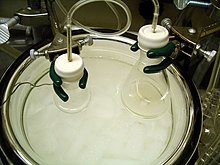Transfer cannula

A transfer cannula is used in the laboratory to transfer liquids from one vessel to another while excluding the atmosphere . In particular, larger amounts of liquid can be conveniently transferred.
There are different types of transfer cannulas. The most widespread is a steel capillary cut diagonally on both sides , Teflon tubes are still in use , which are either also cut obliquely on both sides or connected via special cannulas (see picture).
To transfer the liquid, both flasks are closed with a septum ( puncture rubber ). The pistons are connected to the transfer cannula so that it is immersed in the liquid to be transferred. An overpressure must be built up on the piston with the liquid, for example by means of a balloon filled with inert gas . So that the liquid can now get into the other piston, the pressure must be able to decrease there. For example, a cannula is simply pierced through the septum. It is also possible to create a negative pressure on this side.
gallery
Options for using a transfer cannula:
1: Pressure supply (gas inlet) 2: Pressure release ( bubble counter , orange) 3: Upper flask with liquid to be transferred (yellow) 4: Lower flask for liquid intake / transferred liquid (yellow)
5: Transfer cannula 6: Septum (orange) on the storage flask 7: Septum (orange) on the reaction flask 8: Pressure control regulator / plug
9: Hose (not shown for the sake of clarity, the arrows indicate the course of the gas) 10: Gas cannula 11: Two-way cock for closing the gas cannula 12: Gas- tight syringe
13: Gas / pressure from piston 3 14: Gas / pressure in piston 4
O = open tap; X = valve closed; Black arrow = direction of gas flow, orange arrow = direction of liquid flow





